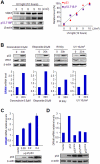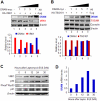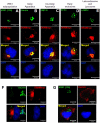Downregulation of VRK1 by p53 in response to DNA damage is mediated by the autophagic pathway
- PMID: 21386980
- PMCID: PMC3046209
- DOI: 10.1371/journal.pone.0017320
Downregulation of VRK1 by p53 in response to DNA damage is mediated by the autophagic pathway
Abstract
Human VRK1 induces a stabilization and accumulation of p53 by specific phosphorylation in Thr18. This p53 accumulation is reversed by its downregulation mediated by Hdm2, requiring a dephosphorylated p53 and therefore also needs the removal of VRK1 as stabilizer. This process requires export of VRK1 to the cytosol and is inhibited by leptomycin B. We have identified that downregulation of VRK1 protein levels requires DRAM expression, a p53-induced gene. DRAM is located in the endosomal-lysosomal compartment. Induction of DNA damage by UV, IR, etoposide and doxorubicin stabilizes p53 and induces DRAM expression, followed by VRK1 downregulation and a reduction in p53 Thr18 phosphorylation. DRAM expression is induced by wild-type p53, but not by common human p53 mutants, R175H, R248W and R273H. Overexpression of DRAM induces VRK1 downregulation and the opposite effect was observed by its knockdown. LC3 and p62 were also downregulated, like VRK1, in response to UV-induced DNA damage. The implication of the autophagic pathway was confirmed by its requirement for Beclin1. We propose a model with a double regulatory loop in response to DNA damage, the accumulated p53 is removed by induction of Hdm2 and degradation in the proteasome, and the p53-stabilizer VRK1 is eliminated by the induction of DRAM that leads to its lysosomal degradation in the autophagic pathway, and thus permitting p53 degradation by Hdm2. This VRK1 downregulation is necessary to modulate the block in cell cycle progression induced by p53 as part of its DNA damage response.
Conflict of interest statement
Figures






Similar articles
-
p53 downregulates its activating vaccinia-related kinase 1, forming a new autoregulatory loop.Mol Cell Biol. 2006 Jul;26(13):4782-93. doi: 10.1128/MCB.00069-06. Mol Cell Biol. 2006. PMID: 16782868 Free PMC article.
-
Protein kinase Cδ regulates vaccinia-related kinase 1 in DNA damage-induced apoptosis.Mol Biol Cell. 2011 Apr 15;22(8):1398-408. doi: 10.1091/mbc.E10-08-0717. Epub 2011 Feb 23. Mol Biol Cell. 2011. PMID: 21346188 Free PMC article.
-
Phosphorylation of vaccinia-related kinase 1 at threonine 386 transduces glucose stress signal in human liver cells.Biosci Rep. 2020 Apr 30;40(4):BSR20200498. doi: 10.1042/BSR20200498. Biosci Rep. 2020. PMID: 32266931 Free PMC article.
-
Evidence for the interplay between JNK and p53-DRAM signalling pathways in the regulation of autophagy.Autophagy. 2010 Jan;6(1):153-4. doi: 10.4161/auto.6.1.10537. Epub 2010 Jan 5. Autophagy. 2010. PMID: 19949306 Review.
-
Implication of the VRK1 chromatin kinase in the signaling responses to DNA damage: a therapeutic target?Cell Mol Life Sci. 2018 Jul;75(13):2375-2388. doi: 10.1007/s00018-018-2811-2. Epub 2018 Apr 20. Cell Mol Life Sci. 2018. PMID: 29679095 Free PMC article. Review.
Cited by
-
Three-dimensional microenvironment confers enhanced sensitivity to doxorubicin by reducing p53-dependent induction of autophagy.Oncogene. 2015 Oct 16;34(42):5329-40. doi: 10.1038/onc.2014.461. Epub 2015 Jan 26. Oncogene. 2015. PMID: 25619836
-
GDF-15 Suppresses Puromycin Aminonucleoside-Induced Podocyte Injury by Reducing Endoplasmic Reticulum Stress and Glomerular Inflammation.Cells. 2024 Apr 5;13(7):637. doi: 10.3390/cells13070637. Cells. 2024. PMID: 38607075 Free PMC article.
-
VRK1 Phosphorylates Tip60/KAT5 and Is Required for H4K16 Acetylation in Response to DNA Damage.Cancers (Basel). 2020 Oct 15;12(10):2986. doi: 10.3390/cancers12102986. Cancers (Basel). 2020. PMID: 33076429 Free PMC article.
-
VRK1 regulates Cajal body dynamics and protects coilin from proteasomal degradation in cell cycle.Sci Rep. 2015 Jun 12;5:10543. doi: 10.1038/srep10543. Sci Rep. 2015. PMID: 26068304 Free PMC article.
-
Integrating DNA damage response and autophagy signalling axis in ultraviolet-B induced skin photo-damage: a positive association in protecting cells against genotoxic stress.RSC Adv. 2020 Oct 1;10(60):36317-36336. doi: 10.1039/d0ra05819j. eCollection 2020 Oct 1. RSC Adv. 2020. PMID: 35517978 Free PMC article. Review.
References
-
- Sengupta S, Harris CC. p53: traffic cop at the crossroads of DNA repair and recombination. Nat Rev Mol Cell Biol. 2005;6:44–55. - PubMed
-
- Horn HF, Vousden KH. Coping with stress: multiple ways to activate p53. Oncogene. 2007;26:1306–1316. - PubMed
-
- Baehrecke EH. Autophagy: dual roles in life and death? Nat Rev Mol Cell Biol. 2005;6:505–510. - PubMed
-
- Saito S, Yamaguchi H, Higashimoto Y, Chao C, Xu Y, et al. Phosphorylation Site Interdependence of Human p53 Post-translational Modifications in Response to Stress. J Biol Chem. 2003;278:37536–37544. - PubMed
Publication types
MeSH terms
Substances
LinkOut - more resources
Full Text Sources
Molecular Biology Databases
Research Materials
Miscellaneous

